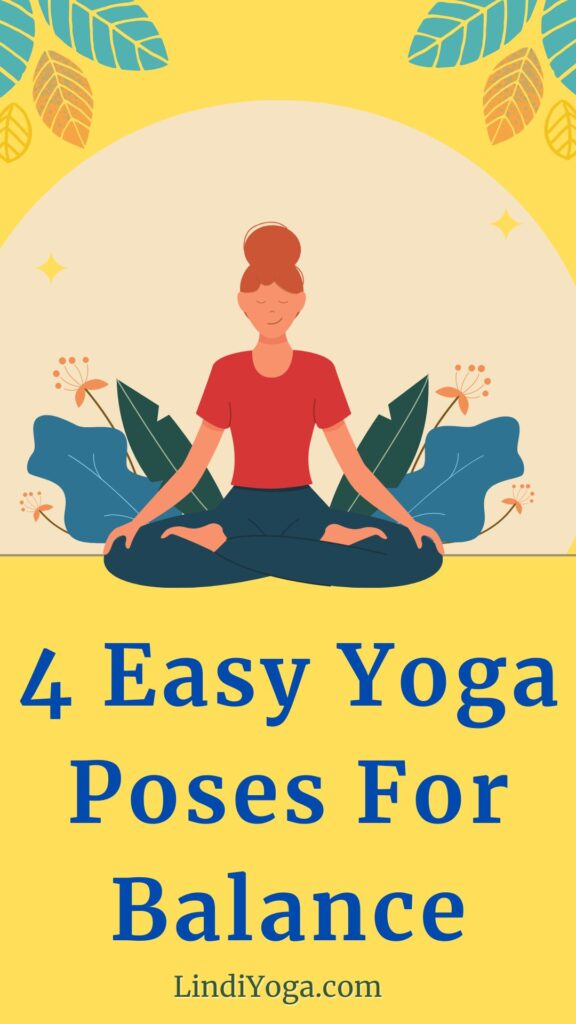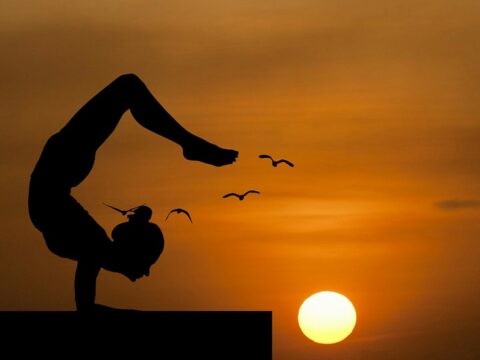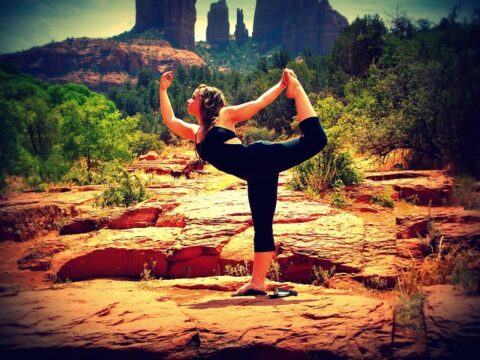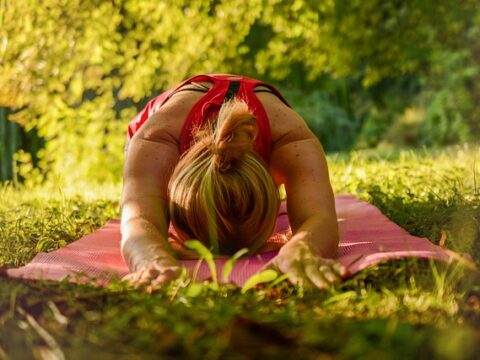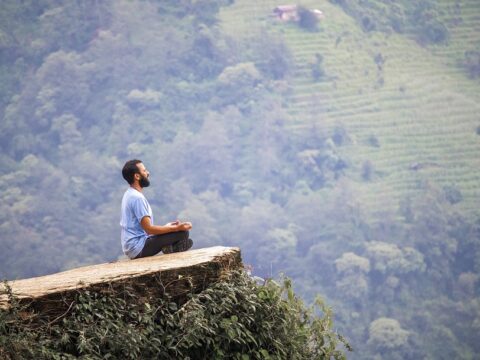Balance poses in yoga help improve physical balance. Good balance prevents injury, sharpens focus and relieves stress. Balance involves touch, inner ear vestibular system, and vision. These send signals to the central nervous system. That’s what enables us to balance.
We’ve all tripped and struggled to regain balance. Standing on one leg is hard without wobbling. Sports like surfing and skating demand good balance. But everyday activities like walking, stairs and carrying groceries also require balance.
Yoga balance poses build strength and stability. They train the small stabilizer muscles. As those get stronger, your overall balance improves. A solid core and good coordination help too.
Poses like Tree, Eagle, Dancer’s Pose and Half Moon challenge balance. As you practice them, you’ll feel yourself getting steadier. Your focus and confidence will increase too. Balance poses take concentration. That mindfulness then carries off the mat into daily life.
Podcast
What are the benefits of balancing Yoga poses?
Balance poses in yoga have many benefits, some of which are shared among all the different poses.
1. Physical Benefits
Balance poses benefit physical and mental health. They align the body, strengthen muscles and explore center of gravity.
Regular practice enhances the vestibular system. This inner ear area controls balance. It has dynamic and static receptors. Dynamic receptors respond to movement – rotation, acceleration, deceleration. Static receptors recognize the body’s position to gravity – upright, lying down, etc.
As you practice balance poses, these receptors improve. Your stability and coordination get better. Standing on one leg becomes easier. Your muscles learn to fire quickly to avoid wobbling. Fear of falling lessens.
Poses like Tree, Eagle and Half Moon develop strong cores. As your foundation strengthens, you feel steady and grounded. Balance skills transfer off the mat too. Your posture and grace improve. Cultivating equilibrium brings greater ease of being.
Keep breathing deeply in balance poses. Stay calm and focused. The concentration required builds mental strength. Overall, balancing postures align us physically and emotionally. We experience profound mind-body connection.
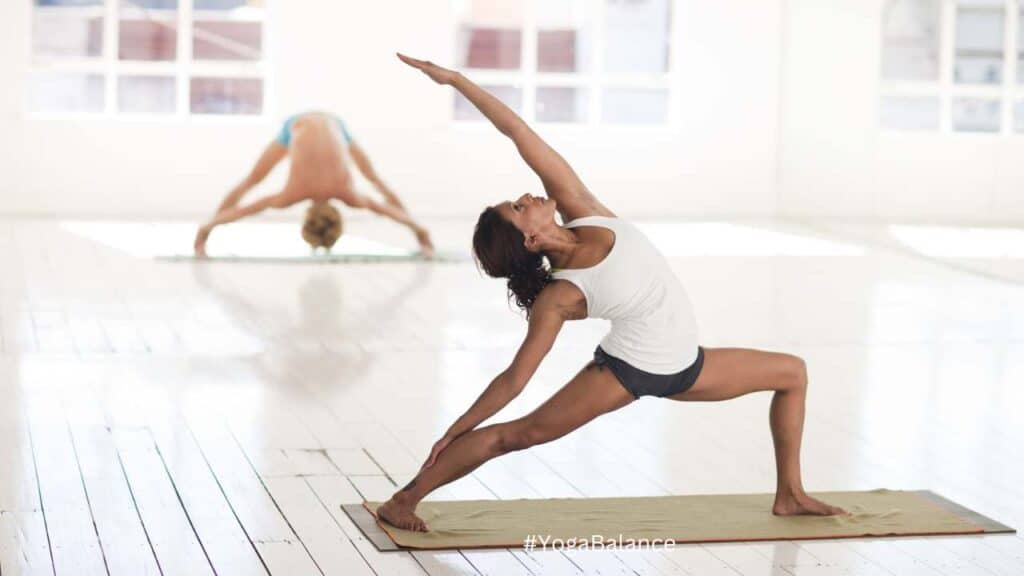
2. Mental Benefits
Balance in yoga goes beyond physical stability. Balance poses also cultivate mental and emotional steadiness.
Standing on one leg takes concentration. You have to stay focused to avoid wobbling over. It takes effort to find equilibrium and stand tall. External distractions must be disregarded.
This mindfulness transfers off the mat. Balance poses teach patience and calmness. They build awareness and control. Life’s challenges are met with more clarity and ease.
The deep breathing in balancing postures reduces stress. Emotional steadiness arises from the inner focus required. Overall poise and grace improve as mind and body align.
Tree Pose, Eagle Pose, Half Moon – these build confidence. Your core strengthens, fostering self-assurance. Mind-body connection deepens through the integration of effort and ease. Balance on the mat leads to balance in life.
9 Tips to improve your balance in Yoga poses
- Create a regular practice. A regular yoga practice will help you develop better balance and coordination.
- Work on your balance in standing poses. Stand on one leg and work on your balance in standing poses. You can also try standing on your hands or head.
- Use props. Props can help you improve your balance in yoga poses. Try using a block or strap when you practice.
- Don’t rush. Take your time when you are working on your balance. rushing will only make it harder for you to maintain your balance.
- Focus on your breath. Remember to breathe deeply when you are working on your balance. This will help you focus and stay calm.
- Stay present. Stay aware of your body and mind when you are working on your balance. This will help you stay present and focused.
- Let go of expectations. Don’t worry about perfecting your balance. Just focus on doing your best and enjoying the process.
- Be patient. It takes time to develop better balance. Be patient with yourself and trust that you will improve with regular practice.
- Have fun.
How to start
1. Start at the Base
When doing balance poses, start from the foundation.
Align your body in a straight line from head to tailbone. Connect to the ground first through whatever body part is touching – feet, hands, knees.
Press down firmly through that contact point. Feel grounded and steady. Engage your core. Then stretch up through the crown of your head.
Building from the base up is key for balance. Proper alignment prevents wobbling. Stay focused on each part as you move into the posture.
First, root down through your standing foot. Distribute weight evenly. Activate leg muscles. Level hips. Lift chest. Lastly, extend arms gracefully overhead.
Moving with care and awareness, come into balance. Breathe smoothly. Gaze softly. Find your equilibrium with each mindful movement.
2. Fix Your Gaze
Choose a steady gaze point when balancing. Don’t look too close or far away. Finding a fixed spot to focus on is key.
Softly gazing at one place builds concentration. This focused intention helps you find equilibrium. It also keeps you present and aware.
Distractions disrupt balance. Tuning out visual stimuli allows inward focus. Breathe smoothly as you fix your gaze. Relax eyes and face.
Lightly focusing on a spot anchors you in the posture. It keeps you lifted and aligned as you stand tall. Gazing calmly also settles the mind.
As balance improves, you can gently close eyes. Challenge stability further without visual cues. Deepen your sense of inner poise.
Fixed gaze and focused intention cultivate centeredness. You become steady and graceful in body and mind.
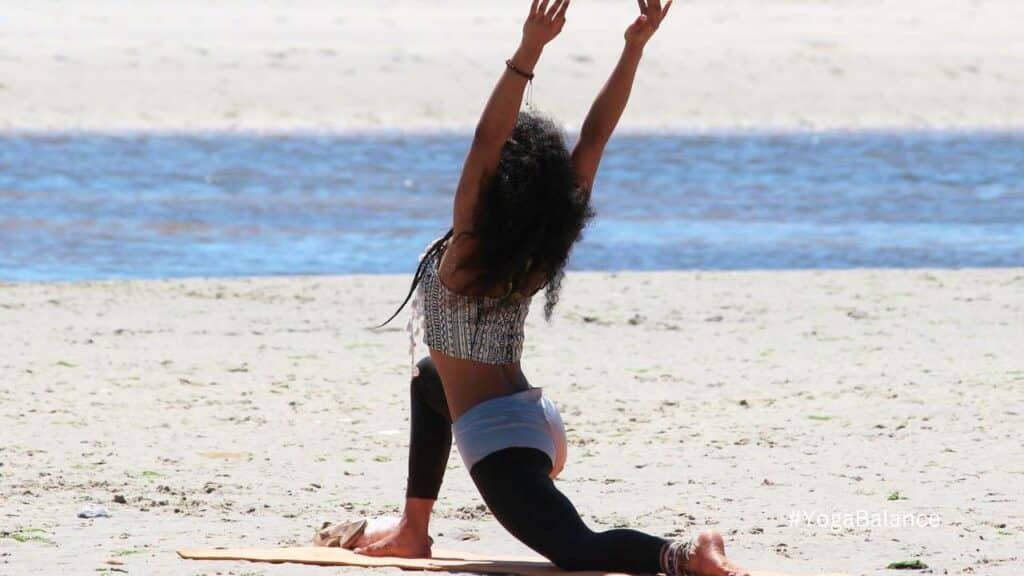
3. Take Your Time
Move slowly and with care when balancing. Sudden motions can make you wobble and fall. Approaching poses patiently makes maintaining equilibrium easier.
Rushing into a posture often leads to losing balance. Regaining stability is harder once you’re off-kilter. So transition gradually with mindfulness.
Take your time settling into the shape. Find your foundation and steady yourself before lifting into the full expression. Breathe smoothly to stay centered.
Pace yourself according to your capability. Don’t push too far too quick. Ease in and out of balancing poses with control.
Patience and presence prevent wobbling. Let go of judgement as you gain stability over time. Keep practicing regularly to improve focus and form.
Moving thoughtfully creates equilibrium. With care, you can find grace and poise in every balancing posture.
4. Get Support
Don’t be afraid to get support in balancing poses. Using a wall, chair or block is wise when starting out. Standing near a wall or doorway provides stability.
Having a friend gently hold your arm builds confidence. Human touch reassures balance is possible. Don’t worry about “perfect” form right away.
Work up to the full expression by progressively reducing support. First two hands on the wall, then one hand, then fingertips. Build strength gradually.
Rather than struggling, get creative with aids like straps. Adapt poses to your current capability. There’s no shame in smart assistance.
Yoga is non-judgemental. Honor your body and its needs. Balance comes with consistent practice over time. Keep breathing and trust the process.
With patience and support, balancing is accessible to all. Feel steady as you stand gracefully tall.
5. Focus on Your Breath
Breathwork is vital for balance poses. Conscious, steady breathing helps you find and maintain equilibrium.
As you transition into a balancing posture, inhale calmly. Once settled, breathe smoothly to stay centered. Soft belly breaths prevent wobbling.
If you start to feel unsteady, pause and take a few deep inhales. This recenters you. Then reconnect to your foundation and lift back up.
Let long exhales release tension as you stand tall. Keep breath relaxed yet intentional. Oxygen fuels and steadies.
Natural breathing rhythms enhance focus. They provide an anchor amidst effort. Link movement with breath flowing freely.
Mindful breathing cultivates inner poise too. Balance on the mat transfers to balance in life. Overall, conscious breath fosters alignment – physically, mentally and emotionally.
6. Don’t Be Afraid
Fear can block us when learning new skills like balancing poses. But don’t be afraid – have fun instead!
If you wobble or fall, laugh it off. Fear of failing limits progress. Stay lighthearted as you build new abilities.
Approach balance practice with curiosity. See it as playing, not performing. Celebrate small successes. Stability develops over time through repetition.
Trust the process. Keep re-centering yourself with patience. Progress will come through consistency. Allow growth to unfold naturally.
Stay present in each moment. Don’t overthink – just breathe. Keep practicing with joy. What seems hard today will feel easier tomorrow.
Have faith in your inner wisdom. With care and compassion, you’ll gain confidence. Balancing postures remind us to embrace life’s journey with optimism and grace.
7. Be Aware of Your Center Line
In balance poses, tune into your center line. Visualize a straight vertical axis through your head, neck and torso.
Being aware of this central alignment is key. It keeps you upright and prevents teetering.
Also pay attention to your head position. The vestibular system in the inner ear controls balance. Keeping your head level aids stability.
Imagine lengthening up through the center as you ground down. Balance happens through dynamic oppositional forces.
Tune out distractions and focus inward. Sense your weight evenly distributed. Refine posture with subtle movements.
Stay concentrated on your foundation and core. Proper alignment minimizes wobbling. Center line awareness brings poise, on and off the mat.
8. Keep the Feet Hip-Width Apart
Balancing is easier when feet are hip-width apart. This stance creates a stable base of support.
If needed, widen your foundation even more. As skills improve, slowly bring feet closer together.
For beginners, balancing on two feet is wise. It builds confidence before lifting one foot.
Distributing weight across a wider base minimizes teetering. Knees track over feet to stack joints.
Engage leg muscles to feel grounded through your stance. Relax toes – grip inhibits balance. Breathe smoothly.
Build good habits early. Proper foundation alignment prevents strain. Listen to your body’s needs as you progress.
With patience and practice, graceful balancing emerges. Stay present and find stability from the ground up.
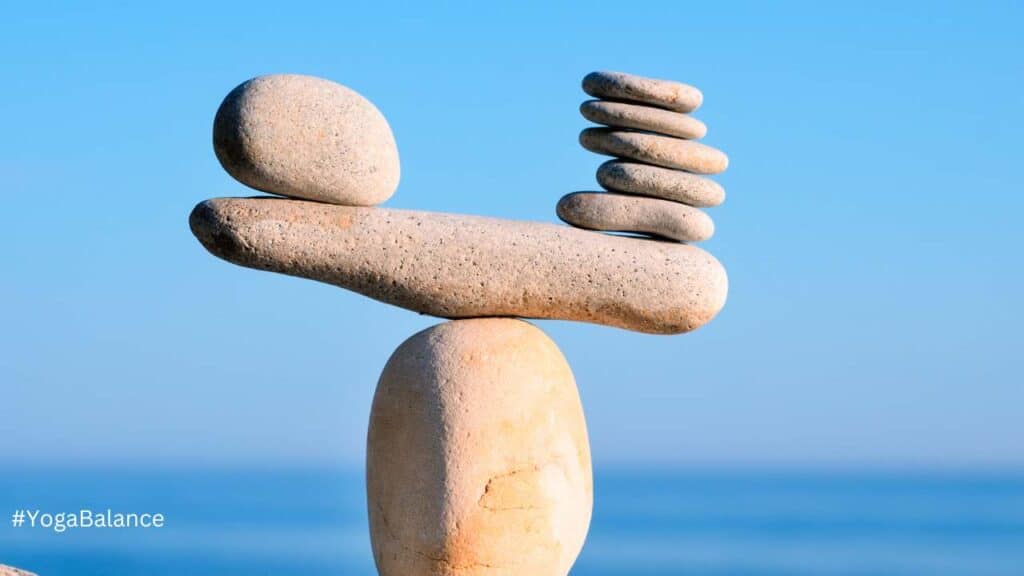
9. Be Patient
Patience is key when learning new skills like balancing poses. No one masters things instantly. Progress takes time and practice.
If you wobble out of a posture, simply try again tomorrow. Don’t get frustrated. Persistence pays off.
Approach balancing with a beginner’s mindset. Stay open and non-judgmental with yourself. Celebrate small signs of stability.
Regularly revisiting challenging balances builds coordination. Let go of preconceived limitations. Allow gradual improvement through repetition.
Trust your inner wisdom to guide you. Breathe through discomfort. Remain focused in each moment. Equilibrium will come if you keep practicing.
Yoga teaches that real transformation unfolds slowly. Keep showing up with compassion. Growth happens through consistency. Stay balanced on your journey.
10. Relax
Yoga is a journey of self-discovery. If you wobble in a balance pose, relax – it’s not the end of the world. Often falling marks the beginning of growth.
Don’t try to prove anything to anyone, including yourself. Enjoy the process without judgment. Keeping your mind relaxed is key for equilibrium.
Breathe through any frustration that arises. Be gentle with yourself as you gain new skills. Celebrate small signs of progress.
Stay present and focused on each moment. Don’t overthink techniques – just explore. Let yoga take you on a path to better balance.
Patience and practice keep perfectionism at bay. Make balancing an act of mindfulness and play. Smile when you sway. Keep your spirit light.
Cultivate equilibrium on and off the mat through self-acceptance. Discover inner poise as you awaken your body with care.
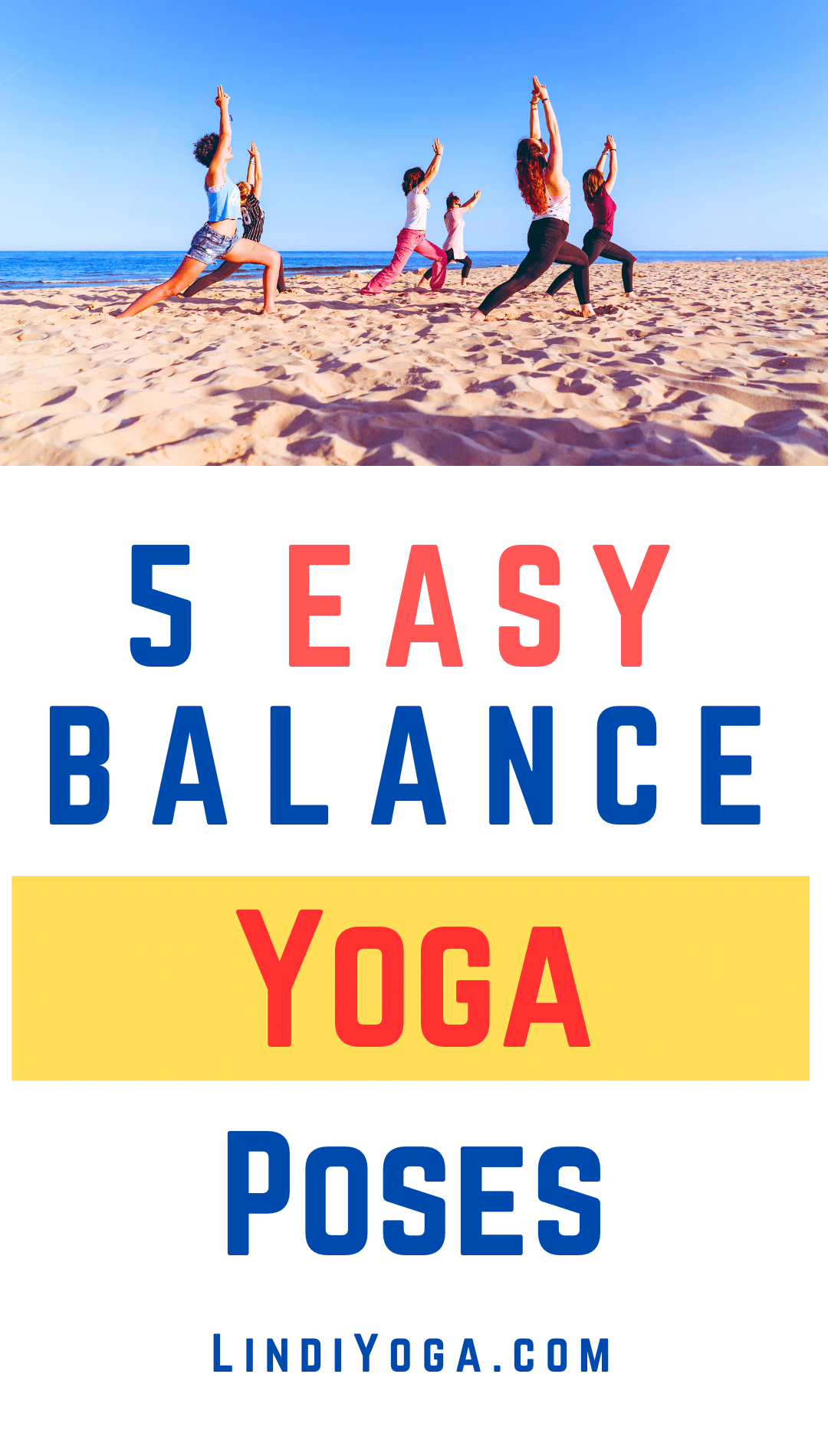
4 Best Yoga poses to build better balance
1. Mountain pose (Tadasana)
Tadasana, or Mountain Pose, is a fundamental standing balance. Mastering this posture builds solid foundations for all yoga poses.
Practice Mountain Pose mindfully, with full-body integration. Firm your muscles without tension – energize without forcing. Engage your core.
Distribute weight evenly across the soles of your feet. Spread toes wide, then relax them. Align knees over ankles. Lengthen your spine.
Lift through the crown of your head as you root down through your feet. Find length in both directions – grounding and elevation.
Breathe smoothly as you stand tall and steady. Build the balance, strength and poise that supports more advanced postures.
Make time regularly for Tadasana. This simple pose realigns you – physically, mentally, emotionally. Mountain Pose brings uplifting, centering effects.
2. Balancing Table pose (Dandayamna Bharmanasana)
Some yoga teachers overemphasize advanced standing balances like Warrior III or Dancer’s Pose. These one-legged poses aren’t beginner-friendly without wall support.
Instead, spending more time on foundational balances like Balancing Table is wise. This pose builds core and leg strength in a stable way.
To come into Table, start on hands and knees. Extend one leg straight back, keeping hips square. Avoid leaning sideways. Engage your center.
Hold for 5 breaths, then switch legs. Stay present. Don’t rush transitions. Build endurance gradually.
Table strengthens arms and shoulders too. Practice with awareness. Breathe fully. Then try lifting the top leg.
Simple, accessible balances like this foster confidence. Mastery paves the way for more challenge later. Be patient with your journey.
3. Tree pose (Vrksasana)
Tree Pose, or Vrksasana, is excellent for cultivating balance. This popular posture offers many benefits for body, mind and spirit.
To find stability, beginners should use a prop like a wall or chair. Stand sideways, hand lightly resting for support. Shift weight to the standing leg.
Once balanced, lift the other foot, placing sole on ankle or inner thigh. Press down through the standing foot to ascend. Avoid tension.
Hands can stay at your heart center or reach overhead like branches. Soften gaze, breathe smoothly. Hold for 5-8 breaths.
Tree Pose improves focus and concentration. It builds lower body strength while opening the hips. Overall poise arises from inner awareness.
Practice patiently with compassion. Balance emerges gradually through repetition. Keep breathing, and you’ll blossom like a graceful tree.
4. Side Plank pose (Vasisthasana)
Side Plank Pose, or Vasisthasana, builds core strength and balance. To come into it, lie on your side and prop your body up on one forearm and the outer edge of your foot.
Make sure your body forms one long, straight line from head to heels. Engage your abdominal muscles to avoid sinking into your shoulder. Keep your hips lifted and spine elongated.
Hold for 5-10 breaths. Feel your obliques and thighs engaging to keep you stable. Breathe smoothly. To deepen the stretch, reach your top arm straight up toward the ceiling.
Practiced regularly, Side Plank tones your core and improves overall balance and stability. The effort of holding your body steady also builds mental focus and concentration. This rejuvenating pose strengthens and relaxes you at the same time.
